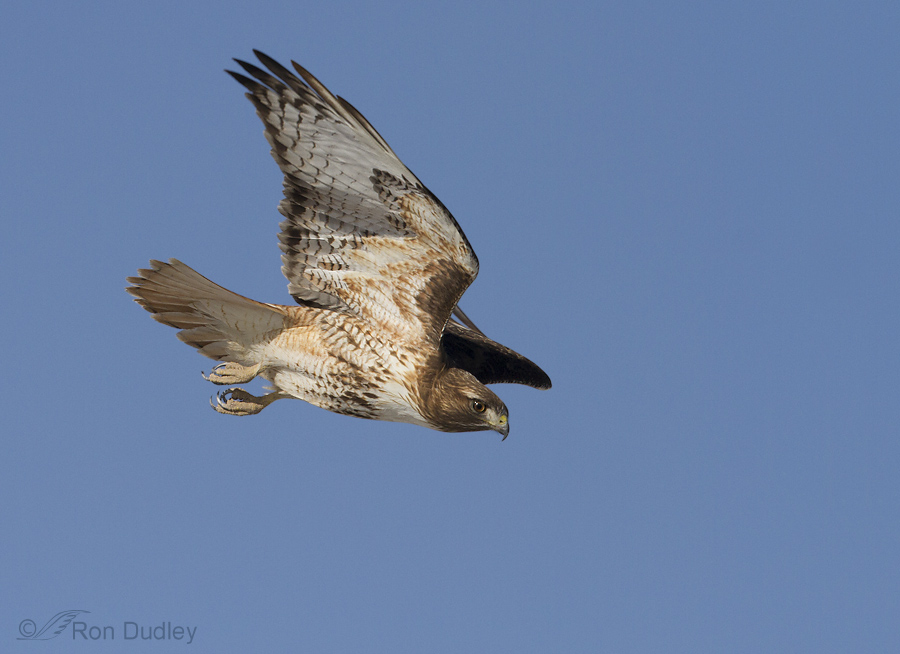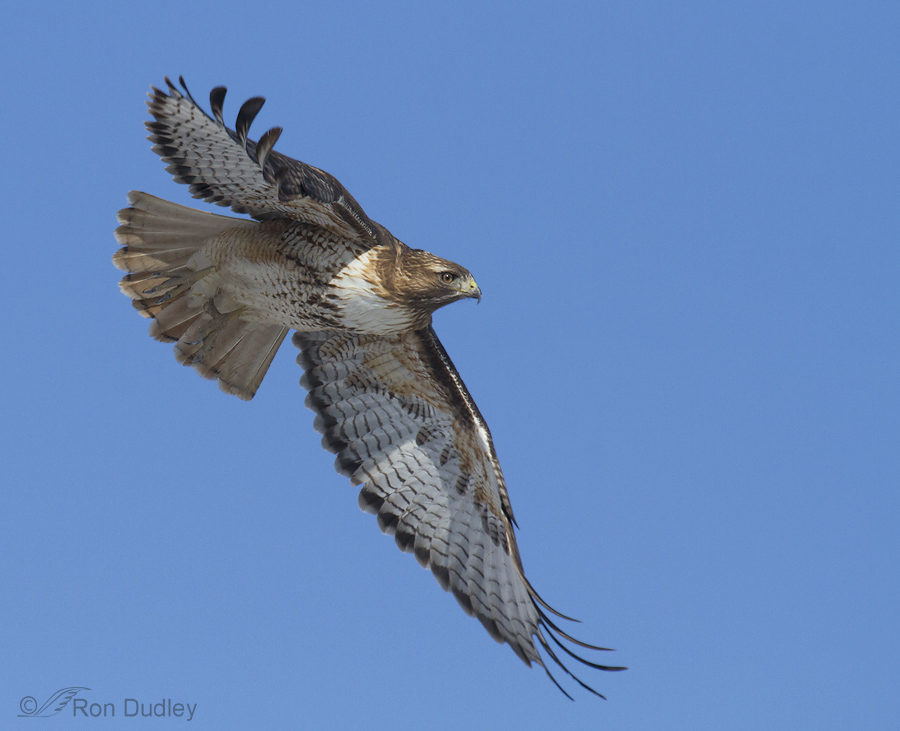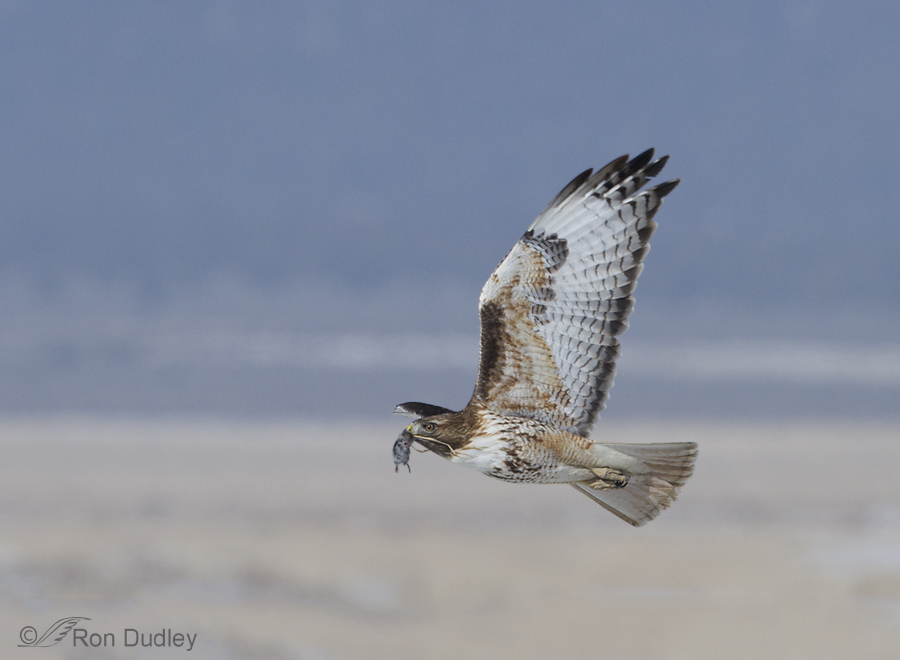Yesterday morning I had a great time photographing an adult Red-tailed Hawk in northern Utah County as it hunted rodents from power poles. The experience was both rewarding and frustrating as I’ll explain.
1/2500, f/8, ISO 500, Canon 7D, 500 f/4, not baited, set up or called in, canvas added for composition
This bird was very methodical in its hunting technique. It would hunt from the top of a pole for about 5 minutes (or less) and then “hopscotch” a pole or two to the east and do it again. It must have repeated the technique almost a dozen times – to the point that I started to think of it as “pole dancing”. There was regular traffic along the road from which I was shooting but the hawk paid it no attention, even when big trucks came along making an incredible racket as they pulled the moderate hill.
1/2000, f/8, ISO 500, Canon 7D, 100-400 @ 390mm. not baited, set up or called in, wire and pole edge removed
The “frustrations” I mentioned above were caused by the blasted power lines! When the hawk would take off it would usually give an initial wing-flap or two and then glide down after prey. The wires were in such a position that I nearly always got the best wing position early on when there was a wire in the frame. That’s exactly what happened with this image and I succumbed to the temptation to remove the wire.
1/3200, f/8, ISO 500, Canon 7D, 500 f/, not baited, set up or called in, canvas added for composition
This hawk was a good hunter. During the time I was with it I saw it catch and eat four rodents. I believe that three of them were voles but one may have been a pocket gopher because it was somewhat larger. Here the bird is returning to a pole with one of the voles (along with some grassy debris).
I always worry about raptors when they have become habituated to hunting from poles next to a busy road and I’m especially concerned about this one because the road is out in the middle of nowhere where traffic speeds are high. Hopefully this young adult has been around long enough to know the dangers and avoid them as best it can.
Ron





These have to be the most beautiful photos I’ve ever seen of a red-tailed hawk. Personally, I am glad that you took the wires out of second photo. That allowed the photo to achieve its full potential.
Hey, Ron!
Your photos are great! Actually, some of them are truly gorgeous. Also, I wanted to follow you on Facebook (I clicked the button on the right, but your Facebook posts are not public, so there’s nothing to follow there – just letting you know, maybe you can come up with something to address this issue).
Thank you, Cristian. I’ll look into the FB issue.
I must say, you grabbed my attention with that title. Love the detail in the feathers and even like seeing it carry its “catch.”
Great post, Ron, and the comments are really informative and interesting!
What a beautiful raptor! And pretty efficient, too!
Here we lose raptors and crows on the road when they feast on road kill. And in some country areas there are rather more dead things on/beside the road than you see alive. Which makes my head and heart hurt.
Gorgeous images Ron – and I so hope that Hawk’s habituation to the road and traffic makes it more, not less, safe.
Yes, I get a stomach ache when I see hawks perched along the roads. Driving back through open grassy country from Missouri to Kansas, I passed five ruined bodies – and observed Red-Tails on wires or roadside trees nearly every mile. One thing we (Wildlife Rescue) teach at our Education programs is to not throw leftover food out the window of your car. Less food to lure rodents and hence, raptors.
Wow Ron! That last shot is so good……it would be hanging on my wall if it were mine 🙂
Thanks!
YAY! You got rid of the the ugly wire, kept the beautiful bird! You didn’t enhance, change, touch-up, or alter the bird, just got rid of an ugly distraction. Thank you!!! 48Dodger(Tim) is so right to worry about these “highway hunters” and the dangers they face…their instinct to go after movement is stronger than caution too many times. I especially hate to see them sitting on poles along divided highways, their attention focused on the “island” between the lanes.. What does “passage” hawks mean?
Thanks, Patty. Here’s one definition for a “passage” raptor. “A term used to describe a bird captured from the wild, often on migration, whilst still in its immature plumage, with the intent to train the bird for falconry”
Thanks…there’s so much to learn!
A “passage” bird must be similar to what some of us call a “dirty bird”. An immature/juvenile eagle, still very spotted/mottled with white. Immature goldens are also called wamblu gleska or spotted eagles.
“Highwya Hunters”….love that, gonna use it! lol
Tim
You’re welcome! Keep Sakura healthy (why did you choose that name? It’s beautiful) PC
It means Cherry Blossom….when I trapped her, she flew from the pole to the trap, then into a cherry orchard. It was there that I started trying different names. When I did a search for cherry trees…I got the name. 🙂 Thanks for asking!
Tim
nice!
What sensational shots Ron! Thanks so much for sharing!
Charlotte
Thanks, Charlotte.
So beautiful.
Thank you, Leisa.
I often tell people of this style of hunting. A car drives by…the prey moves…the hawk strikes. Hunt by the bumper, die by the bumper. Its an extremely effective way to hunt, long as the prey waits to move after the vehicle passes by. I trapped Sakura on a busy Hwy just for this reason, to save her from bad habits and potentionally short life. The mortality rate is high for passage birds who, in most cases, lack the skill for small prey. They are bigger and not as strong a flyer as the smaller adults who have survived the hunting tests of their youth. Bird strikes by cars are in part no accident. When the huntings not good, and a good meal moves….the bird will strike regardless of the danger. They truly are fearless. Its stated in different ways, but the death rate I remember from my testing days was, 80 percent of hawks are dead within the first three years. I often call power poles “The chow line”….cuz well, you get it I’m sure. Another fact for fatalities, is their eyes. Raptors have two focal points (vultures do not), where humans have one. Both are intensely focused on the ground. The also do not see as many colors as most birds do. This is why eagles are having trouble with the Wind Turbines….they don’t see them, they are focused on movement on the ground. This would be true of bumpers as well. Though raptors have eyesight 6-8 times greater than man, they see things almost the same way we do, refering to size shape and color.
I believe your best pictures are of Harrier Hawks, that your personal bird is a Prairie Falcon, and my favorite will always be of the Red-Tailed Hawks..lol. Beautiful shots Ron. 🙂
Tim
Very interesting information from someone who knows, Tim – thank you.
As far as I know these voles seldom (if ever) come onto the road during daytime so that’s a good thing. My biggest concern is that this hawk will see a vole on the other side of the road and go after it just as a big (and tall) truck comes by.
Yes….that’s the senerio I’m speaking of, flying downward across the road.
Hate seeing it when I drive home from the foothills…the tragic loss of a young raptor.
Tim
WOW – great images Ron. Can’t fault you for getting rid of the wire(s). Man made interference begets man made solutions!
For some unknown reason I was always under the impression that Bueto’s went after larger game, e.g. rabbits, squirrels, etc., until I watched a Red-tail hunt from the top of a series of Bluebird boxes I have in back of our house and watched him/her catch several voles/mice. Survival is the name of the game!!
Dick, Funny how things are different in different areas. In all the time I’ve been photographing birds I don’t recall having ever seen a red-tail on a rabbit kill.
Older hawks have the skills for smaller prey…passage hawks don’t..so they tend to go after slower, bigger prey unaware of the potential fight. Smaller prey is also safer against injury. In falconry we teach/train hawks confidence with larger prey. It actually improves their longevity in the wild.
Tim